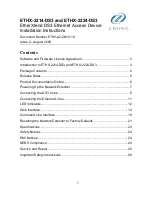
Web Configurator with EEC 2
VLAN
19-1
This chapter explains how to configure VLANs on the line card.
19.1 VLAN
Overview
A VLAN (Virtual Local Area Network) allows a physical network to be partitioned into multiple logical networks.
Stations on a logical network belong to one group. A station can belong to more than one group. With VLAN, a
station cannot directly talk to or hear from stations that are not in the same group(s); the traffic must first go
through a router.
In MTU applications, VLAN is vital in providing isolation and security among the subscribers. When properly
configured, VLAN prevents one subscriber from accessing the network resources of another on the same LAN, thus
a user will not see the printers and hard disks of another user in the same building.
VLANs also increase network performance by limiting broadcasts to a smaller and more manageable logical
broadcast domain. In traditional switched environments, all broadcast packets go to each and every individual port.
With VLAN, all broadcasts are confined to a specific broadcast domain.
Note that VLANs are unidirectional- they only govern outgoing traffic.
19.2 Tagged VLANs (IEEE 802.1Q)
Tagged VLAN uses an explicit tag (VLAN ID) in the MAC header to identify the VLAN membership of a frame
across bridges - tagged VLANs are not confined to the switch on which they were created. The VLANs can be
created statically by hand or dynamically through GVRP. The VLAN ID associates a frame with a specific VLAN
and provides the information that switches need to process the frame across the network. A tagged frame is four
bytes longer than an untagged frame and contains two bytes of TPID (Tag Protocol Identifier, residing within the
type/length field of the Ethernet frame) and two bytes of TCI (Tag Control Information, a tagged header starts after
the source address field of the Ethernet frame).
TPID
2 Bytes
User Priority
3 Bits
CFI
1 Bit
VLAN ID
12 bits
TPID has a defined value of 8100 (hex). The first three bits of the TCI define user priority (giving eight priority
levels). The CFI (Canonical Format Indicator) is a single-bit flag, always set to zero for Ethernet switches. The
remaining twelve bits define the VLAN ID, giving a possible maximum number of 4,096 (212) VLANs. Note that
user priority and VLAN ID are independent of each other. A frame with VID (VLAN Identifier) of null (0) is called
a priority frame, meaning that only the priority level is significant and the default VID of the ingress port is given
as the VID of the frame. Of the 4096 possible VIDs, a VID of 0 is used to identify priority frames and value 4095
(FFF) is reserved, so the maximum possible VLAN configurations are 4,094.
Chapter 19
VLAN
Summary of Contents for ALC1024
Page 1: ...ALC1024 ADSL Line Card Version 2 04 February 2004 User s Guide...
Page 22: ......
Page 50: ......
Page 58: ......
Page 86: ......
Page 106: ......
Page 112: ......
Page 120: ......
Page 126: ......
Page 132: ......
Page 136: ......
Page 165: ......
Page 173: ......
Page 194: ......
Page 196: ......
Page 206: ......
Page 208: ......
Page 226: ......
Page 232: ......
Page 242: ......
Page 246: ......
Page 248: ......
Page 249: ...Index VII Part VII Index This part provides an index of important terms...
Page 250: ......
















































